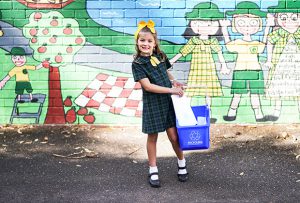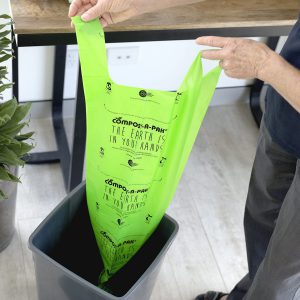
August 03, 2018
The War on Waste in Schools
Did you tune into ABC’s latest ‘War on Waste’ program this week, and get inspired about the scale of change at Kiama High School?
The key to a successful recycling program like Kiama’s really is a passionate change leader!
Once inspired, implementation is most effective when you follow these really simple, best practice strategies, which research suggests will improve your participation and reduce contamination. We have detailed 6 key things to consider if you’re looking to transform your local school in the same way.
1. THINK CAREFULLY ABOUT YOUR RECYCLING BINS

It’s important you choose bins which are convenient to use, and importantly hold the right capacity! Similarly, the bins should always be placed in a station of three in busy thoroughfares, and areas in which waste is generated. If only one type of bin is available in a location, students will use that for everything.
Equally important, if one of your bins fills up too quickly, you will find that all the streams will become mixed as users throw the recyclables anywhere. This behaviour will then be more likely to continue next time they visit the station, even if there is capacity in the right bin.
Not to mention that you need to keep the bins looking loved (or at least neat and clean). If your station instead looks like a mess people will just add to that mess and contaminate your bins. It’s the same principle with litter. Once people perceive an area has been already littered, the likelihood that they will also litter increases dramatically.
To check your volumes requirements, short of a full audit, just look at your existing waste collection volumes before pick up, estimate the percentage of each waste category from a review of each bin, build in some extra capacity and use that to estimate your needs.
The Kiama team choose standard 240 Litre Mobile Garbage Bins (MGB) for their stations, a great cost-effective option for schools. Alternatives to consider would include step-on mechanisms to limit student’s hesitation in lifting lids on multiple bins, particularly if they are perceived as dirty, and bins with differentiated apertures.
2. COLOUR CODE IN AUSTRALIAN STANDARDS AND USE CUSTOMISED APERTURES WHERE POSSIBLE
Making the bins look differentiated at a glance through colours and shapes, reinforced that users need to make a deliberate choice.

Mirroring the Australian standard colours for Landfill (Red), Recycling (Yellow), and Organics (Green) also means that the educational messages about recycling that occur out of the school in public places and through curb-side recycling, reinforce your school’s recycling program.
Whilst lid colours are ideal for this, if your budget doesn’t allow, an alcove with bright paint on the ground and walls can also suffice!
3. EXPLAIN THE ‘WHY’ AND GET PEOPLE ENGAGED
If you don’t have Craig Reuchassal available for your school, that doesn’t mean you can’t build on the #Waronwasteau momentum. There are some really powerful clips from the show, and some great statistics which you can share during your communications.
Similarly aim to run parallel programs such as a nude food day like Kiama’s ‘Trash Free Thursday’, or a recycled sculpture competition, or if you are really enthusiastic, start a garden in which you can compost some of the food waste, to then grow new food. Gardening and composting is a powerful way to demonstrate the principles of closed loop recycling.
 4. MAKE IT CONVENIENT FOR EVERYONE, NOT JUST THOSE USING THE BINS!
4. MAKE IT CONVENIENT FOR EVERYONE, NOT JUST THOSE USING THE BINS!
You may have noticed the bright green Compost-A-Pak bin liners in the green bins. These liners are Australian Certified compostable, so they can be thrown out with the food waste, and composted. This ensures bins stay clean and odour free, and so the cleaners do not have to clean out the food waste bins every few days. Steps like this which improve convenience end to end ensure everyone can embrace the changes.
5. REVIEW YOUR PURCHASING PROCESSES, PARTICULARLY IF THEY END UP AS CONTAMINATION
The best way to reduce Landfill is to avoid waste. Kiama High School has done a great job of getting the canteen on board to reduce waste. With items such as straws being removed or transitioned to paper for composting, this will make a huge difference to landfill, contamination rates and even litter in the school. Similarly, a review of purchasing and school processes across the school in areas such as the office can also highlight some really positive changes such as a transition to online forms etc. Why not assign a sustainability leader to each department to review?
6. THINK ABOUT YOUR WASTE AS A RESOURCE

Kiama High School are making nearly 300 dollars a fortnight from their cans and bottles, which were previously Landfill, through the Container Deposit Scheme. (Similar schemes are now available in most states.) That’s nearly $6,000 a year which helps to cover their initial investment in bins, and is then being used for other Eco-friendly alternatives.
Similarly food waste can be a valuable resource for local farmers who may compost. The nutrients, which are returned to the soil through composting, can improve crops through better quality, more drought resistant soil. It’s a win-win for all!
LAST STEP- HARNESS YOUR PASSION AND MAKE IT HAPPEN!
If you have a powerful story about your local school, don’t forget to share. Join the Culture Shift!